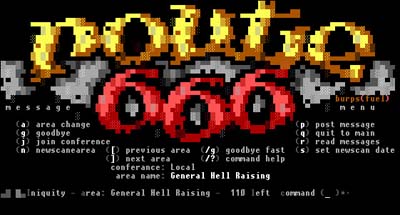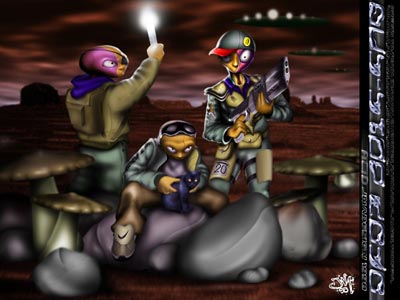| |
The
effect of technology on the scene
by God Among Lice (B. Phillip
Smith) (29 April, 1998)
Contents:
page 1:
1. Introduction
2. The Interface of the BBS and Background of the Art Scene
3. The Rise of the Internet and
the Interface of IRC
page 2:
4. General Issues and The Effect of Multitasking on Attention
5. Habermas' Theory of Cummunicative Action as it Relates to BBS and IRC
6. Conclusion
Introduction
The purpose of this paper is to introduce the reader to the online community of what is generally referred to by its members as the
underground computer art scene, and to demonstrate the ways in which the adoption of new technology and new interfaces for
communication have affected this community. Specifically, it will be shown that technology has served to reduce the amount of
attention given to communication, and that changes in communication interface have caused an increase in distorted
communication through the creation of issues of power and authority as well as a lack of trust among community members.
The Interface
of the BBS and Background of the Art Scene
As is explained below, the underground computer art scene was formed within the context of electronic bulletin board systems
(BBS or boards). Therefore, it seems natural to begin with a description of the services that BBS provide and the nature of the
interface through which users access and utilize these services.
At the heart of most boards are both a directory of files available for download and a system for posting and reading messages.
Often the file directories are divided into categories, like games, utilities, or graphics. Similarly, message boards usually contain
from several to many different areas of conversational topics. A user wishing to participate in a conversation usually will pick an
area of interest, read any new messages that others have posted since the user last looked at that message area, and then either
reply to something that has been written or post a new message concerning a new topic. In both cases the message will be added
to the end of the list of all messages stored in that area. Usually each message is assigned a number, and any future reader would
typically read all of the messages in numerical (and chronological) order. Most boards also support sending private messages to
other individual users as a more direct and less public form of communication.
In addition, many BBS support a number of other features. Online games can be very popular, and can allow people to play
together or against one another, usually in an asynchronous manner, although larger boards that support multiple callers at one
time may support more synchronous or real-time games. Another feature that larger multi-node boards allow is synchronous
chatting among users who are online concurrently. Even with single-node systems, a user can typically page the system operator
(sysop) and if the sysop is present and available, the two can chat with one another in real time. Some other features that may be
found on a board include lists of other BBS that users can add to, "oneliner" programs that let users leave a short humorous quip
or advertisement to be seen by others when logging on, and even matchmaking programs and classified ads. Essentially the
features found on a BBS are limited only by the sysop's available time and effort spent, as well as what s/he [1] feels is
appropriate to the scope or theme of the board.
Although the interface for a BBS can work just fine by consisting only of plain ASCII text command prompts and displays, most
BBS (especially those used mainly as a form of leisure) employ ANSI graphics as a more eye-pleasing alternative. The ANSI
protocol is essentially a standard for displaying ASCII characters that have been given attributes like position, color, and other
display information. With some creativity, simple pictures and logos can be made to spice up the drab text-centered BBS world.

An example of a custom menu from an underground board
The underground computer art scene developed as a direct response to a need for these pictures and logos from sysops of
bulletin boards who didn't have the time or artistic talent to create them themselves. Although there were a good deal of people
creating ANSIs for many different kinds of boards, a community or scene arose among those creating art for "underground"
boards, such as those trading pirated software, or those that dealt with hacking or phreaking. [2] Emerging BBS relating to the
ANSI art scene thus carried over much of the underground nature of those boards.

An example of a welcome screen from a PD board
An underground board generally differs from a public domain (PD) board in several respects. First and foremost, access to an
underground board is generally more restrictive. New users usually have to give references of accepted members of the board or
other boards, answer quizzes to demonstrate sufficient knowledge about the scene, or write a message to the sysop explaining
why they feel they should be accepted. (Meyer:59) Sysops of underground boards often take pride in their setup. A board that
uses default settings, menus, and other options that come with a BBS software would be considered "lame" and too PD, whereas
a board with many custom menus and other ANSI screens created by well-known ANSI artists and which has been modified by
the sysop to include many customized commands and features would be highly respected and more "elite". Thus underground
boards generally each display their own brand of uniqueness, and this uniqueness is due both to the visual appearance of the
board, as well as the noticeable differences in interface and site organization that each sysop has imposed through custom
modifications.

An example of a custom message reader from an underground board
The Rise of
the Internet and the Interface of IRC
Over the past several years, the rapid growth of the Internet and changing technology have affected the underground computer art
scene tremendously in terms of its focus, organization, and methods of communication. The first noticeable effects came in the
form of changes in drawing media. As technology allowed the use of graphical user interfaces in operating systems to become
more widespread, thus lessening the use of text- mode based applications, more artists began to create bitmap, or vga art, as it is
commonly referred to within the scene. With the introduction of the graphical World Wide Web, the demand for such art has
increased proportional to the rise in the web's popularity, to the point where there are now at least as many people drawing vga
as there are ANSI. The rise in popularity of the Internet as a primary means of communicating and gathering information has
essentially caused it to replace almost completely the use of independently operated bulletin boards as a method of accomplishing
those same tasks. More and more, ANSI artists are creating their art not for a specific BBS, but simply for the act of creation;
this is because fewer and fewer BBS exist that can be drawn for.

An example of a vga artwork (by JNA of ACiD, half size)
In place of bulletin board messaging systems, most of those associated with the underground computer art scene now
communicate through the use of Internet email and Internet Relay Chat (IRC). Email is typically reserved for important
person-to-person messages, although there do exist some conversational intra-group mailing lists. The bulk of communication,
though, occurs on IRC. To understand fully the differences in communication patterns between BBS and IRC, an explanation of
the interface and organization of IRC is needed first.
The basis of communication in IRC centers around channels. A channel is like a room with people in it, with each person taking
turns speaking. Each user has a nickname and an optional longer identification that others can see by using a whois command on
that nickname. Each statement said by a user is displayed in the channel for all to see. A channel has a name and a current topic
for conversation, and can have other options set, such as invite only mode, passwords to get in, or a limit to the number of people
allowed in. The first person to enter a channel has operator status (s/he is an "op"), and can change those settings for the channel,
as well as grant others operator status ("give ops"). In addition, someone with ops can invite someone to join the channel, as well
as kick a person out of the channel or even ban them altogether. Any user can also privately message any other user. There are
several different large IRC servers and many smaller ones. Each server may have its own server mode options set differently from
others, allowing longer or shorter nicknames, for example. Some servers are physically located in a specific region, and thus
provide better performance for those living nearby, whereas others are larger networks of many servers dispersed over a large
area. For example, IRC-NET has most of its servers located throughout Europe and thus has a larger number of European users,
whereas EFnet is more equally distributed throughout the U.S., Canada, and Europe. The underground computer art scene is
located almost entirely on EFnet.

|